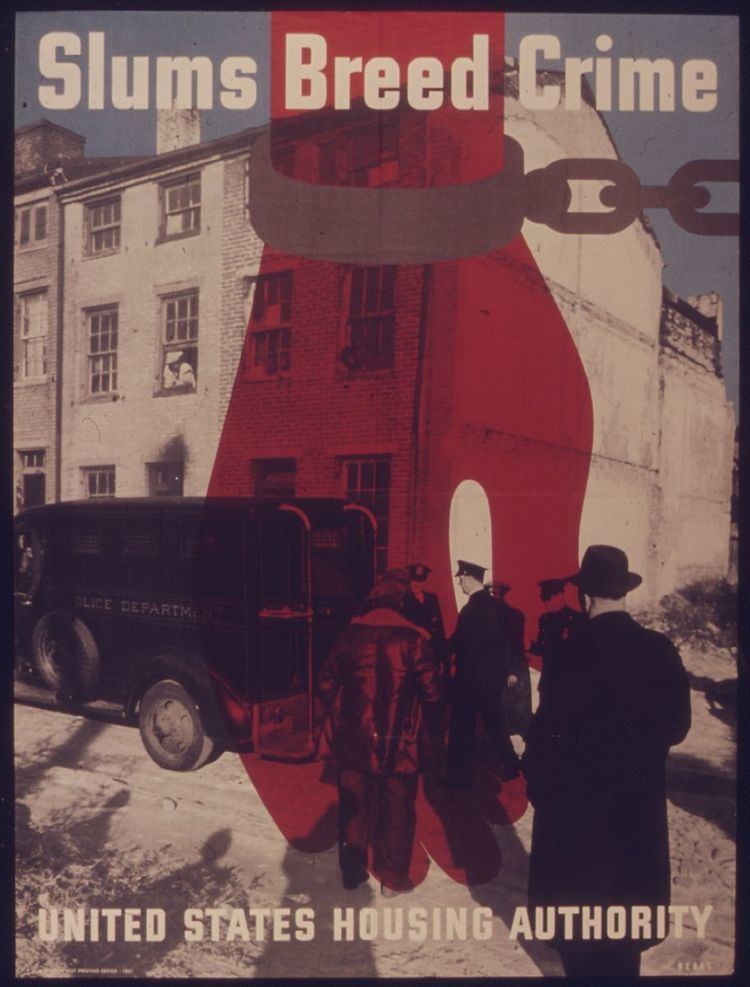Formed 1937 | ||
 | ||
Dissolved Abolished pursuant to the Reorganization Plan No. 3 of 1947 Parent agency Moved under the National Housing Authority of the Federal Works Agency and redesignated as the Federal Public Housing Authority on February 24, 1942 | ||
The United States Housing Authority, or USHA, was a federal agency created during 1937 within the United States Department of the Interior by the Housing Act of 1937 as part of the New Deal.
Contents
It was designed to lend money to the states or communities for low-cost construction.
History
Units for about 650,000 low-income people but mostly homeless were started. Progressives early in the 20th century had argued that improving the physical environment of poorer citizens would improve their quality of life and chances for success (and cause better social behavior). As governor of New York, Al Smith began public housing programs for low income employed workers. New York Senator Robert F. Wagner carried those beliefs into the 1930s, when he was a power in the United States Congress. From 1933-37, the Public Works Administration (PWA) under Harold Ickes razed 10,000 slum units and built 22,000 new units, with the primary goal of providing construction jobs. Ickes was a strong friend of African-Americans and reserved half the units for them. The courts ruled the PWA lacked eminent domain power to condemn slums, so the Housing Act of 1937 envisioned a long term federal role under the new agency, the USHA.
This Housing Act of 1937 was strongly influenced by Catherine Bauer. She became its Director of Information and Research, a position she held for two years.
The private sector saw an economic danger in nationalized housing, and insisted that there be a clear differentiation between the main housing industry and welfare programs focused on people too poor to buy but who were worthy and deserved help. There was a concerted effort, in the words of Senator Wagner, at "avoiding competition" between the private and public sectors. The law required a 20 percent gap between the upper income limits for admission to public housing projects and the lowest limits at which the private sector provided decent housing. Wagner obtained support from conservative leaders Robert A. Taft and Allen Ellender to guarantee a bipartisan approach. Ellender insisted and civil rights groups accepted, that the units be racially segregated. Critics eventually pointed to the culture of poverty, violence, drugs, crime and hopelessness that thrived in the "vertical ghetto" as a refutation of the original Progressive theory.
Defenders of public housing point out that the program was beset with limitations at its outset, has never been truly fully funded, and continues to serve a limited income population that the private real estate sector has never tried to serve.
Organizational structure
The USHA was created by the Housing Act of 1937.
The USHA was reorganized under the Federal Works Agency (FWA) pursuant to the Reorganization Plan No. 1 of 1939 as authorized under the Reorganization Act of 1939, along with the Works Progress Administration (WPA), Bureau of Public Roads, Public Buildings Branch of the Procurement Division, Branch of Buildings Management of the National Park Service, and the Federal Emergency Administration of Public Works.
By Executive Order 9070 (using authority granted under the First War Powers Act), the U.S. Housing Authority was moved under the National Housing Authority of the Federal Works Agency and redesignated as the Federal Public Housing Authority on February 24, 1942.
The USHA was abolished and consolidated within the Housing and Home Finance Agency pursuant to the Reorganization Plan No. 3 of 1947 as authorized under the Reorganization Act of 1945, along with the Home Owners' Loan Corporation (HOLC), the Federal Savings and Loan Insurance Corporation (FSLIC), the Federal Housing Administration (FHA), the Defense Homes Corporation, and the United States Housing Corporation.
